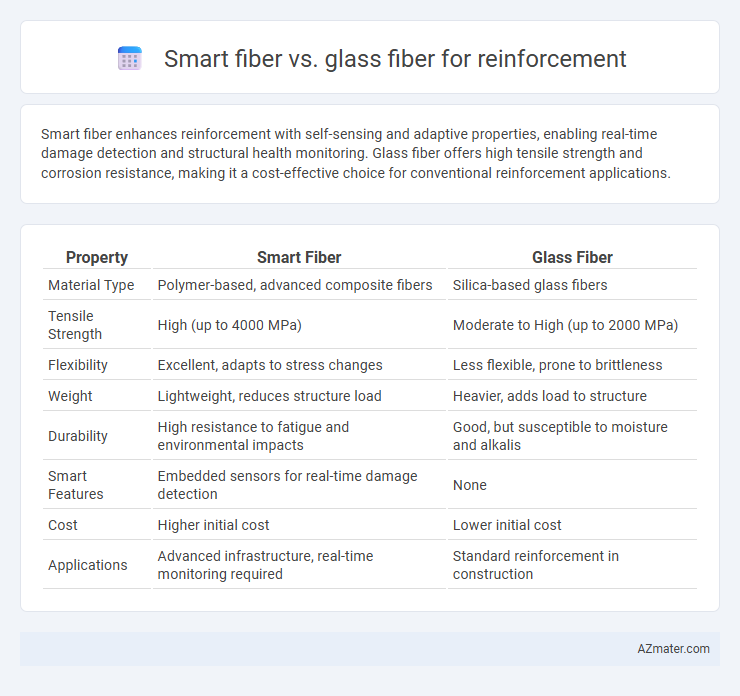Smart fiber enhances reinforcement with self-sensing and adaptive properties, enabling real-time damage detection and structural health monitoring. Glass fiber offers high tensile strength and corrosion resistance, making it a cost-effective choice for conventional reinforcement applications.
Table of Comparison
| Property | Smart Fiber | Glass Fiber |
|---|---|---|
| Material Type | Polymer-based, advanced composite fibers | Silica-based glass fibers |
| Tensile Strength | High (up to 4000 MPa) | Moderate to High (up to 2000 MPa) |
| Flexibility | Excellent, adapts to stress changes | Less flexible, prone to brittleness |
| Weight | Lightweight, reduces structure load | Heavier, adds load to structure |
| Durability | High resistance to fatigue and environmental impacts | Good, but susceptible to moisture and alkalis |
| Smart Features | Embedded sensors for real-time damage detection | None |
| Cost | Higher initial cost | Lower initial cost |
| Applications | Advanced infrastructure, real-time monitoring required | Standard reinforcement in construction |
Overview of Fiber Reinforcement Technologies
Smart fiber reinforcement integrates advanced materials like shape memory alloys and carbon nanotubes, enhancing structural adaptability and damage sensing capabilities. Glass fiber reinforcement, widely used for high tensile strength and corrosion resistance, remains a cost-effective solution in composite materials. Innovations in smart fibers offer improved durability and multifunctional performance compared to traditional glass fibers in construction and aerospace applications.
What Are Smart Fibers?
Smart fibers are advanced reinforcement materials embedded with sensors or responsive elements that detect strain, temperature, or damage within composites, offering real-time monitoring capabilities. Unlike traditional glass fibers, which provide static mechanical strength, smart fibers enhance structural health monitoring and adaptive performance in reinforced materials. Their integration improves durability and safety by enabling proactive maintenance through timely detection of structural changes.
Glass Fiber: Properties and Advantages
Glass fiber exhibits high tensile strength, excellent thermal stability, and superior chemical resistance, making it a preferred reinforcement material in composite applications. Its lightweight nature combined with cost-effectiveness and corrosion resistance enhances structural durability and reduces maintenance costs. The inherent electrical insulation properties and dimensional stability of glass fiber further contribute to its widespread use in automotive, aerospace, and construction industries.
Mechanical Performance: Smart Fiber vs Glass Fiber
Smart fibers exhibit superior mechanical performance compared to glass fibers, offering enhanced tensile strength and improved crack resistance due to their adaptive stress distribution properties. Unlike traditional glass fibers, smart fibers possess self-sensing capabilities that enable real-time monitoring of structural integrity and damage progression. These advantages make smart fibers more effective in applications requiring durability, longevity, and advanced mechanical resilience.
Durability and Longevity Comparison
Smart fiber reinforcement offers enhanced durability by incorporating self-sensing and self-healing properties, which prolong the lifespan of composite materials compared to traditional glass fiber. Glass fiber is known for its high tensile strength and resistance to chemical corrosion, yet it lacks the adaptive longevity features present in smart fibers. The durability of smart fibers reduces maintenance needs and extends structural integrity over time, making them superior in long-term performance for reinforcement applications.
Applications in Construction and Engineering
Smart fiber reinforcement integrates sensor technology within fiber materials, enabling real-time structural health monitoring in construction and engineering applications, while glass fiber reinforcement offers superior tensile strength and corrosion resistance ideal for load-bearing components and concrete enhancement. Smart fibers are predominantly used in smart infrastructure projects requiring durability and data-driven maintenance, whereas glass fibers serve extensively in bridge decks, panels, and industrial flooring due to their lightweight and cost-effectiveness. Combining smart fiber's monitoring capabilities with the mechanical strength of glass fiber can optimize structural performance and longevity in advanced engineering solutions.
Cost Analysis: Initial and Long-Term Investment
Smart fiber reinforcement typically demands a higher initial investment due to advanced material technology and manufacturing processes, while glass fiber offers more affordable upfront costs attributed to widespread availability and simpler production. Long-term investment analysis reveals smart fibers can reduce maintenance and repair expenses by enhancing structural durability and self-sensing capabilities, leading to potential cost savings over the lifespan of construction projects. Glass fiber, although cost-effective initially, may incur higher lifecycle costs due to susceptibility to environmental degradation and comparatively lower performance in crack detection and prevention.
Sensing and Monitoring Capabilities
Smart fiber reinforcement integrates embedded sensors enabling real-time structural health monitoring and damage detection, surpassing traditional glass fiber in providing continuous data on strain, temperature, and stress distribution. Glass fiber offers high tensile strength and corrosion resistance but lacks intrinsic sensing capabilities, requiring external sensor integration for monitoring purposes. The advanced sensing functionality of smart fibers facilitates predictive maintenance and enhances safety in infrastructure applications.
Sustainability and Environmental Impact
Smart fiber reinforcement, often made from bio-based or recyclable materials, offers enhanced sustainability by reducing reliance on non-renewable resources and enabling easier end-of-life recycling processes. Glass fiber, while durable and widely used, involves energy-intensive production with significant carbon emissions and poses recycling challenges due to its non-biodegradable nature. The shift towards smart fibers supports lower environmental impact through reduced raw material extraction, decreased waste generation, and improved lifecycle sustainability in composite reinforcement applications.
Future Trends in Fiber Reinforcement
Smart fiber reinforcement integrates embedded sensors and adaptive materials, enabling real-time structural health monitoring and self-healing capabilities, which significantly enhance durability and safety in construction. Glass fiber remains widely used for its cost-effectiveness and high tensile strength but lacks the advanced functional properties of smart fibers. Future trends indicate a shift towards hybrid composites that combine smart fibers with traditional glass fibers to optimize performance, sustainability, and intelligent infrastructure management.

Infographic: Smart fiber vs Glass fiber for Reinforcement
 azmater.com
azmater.com